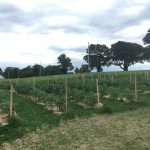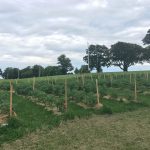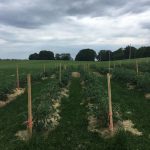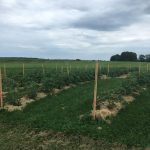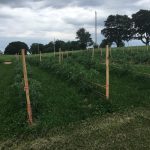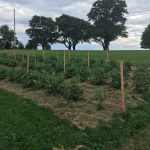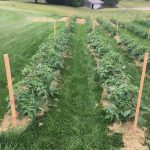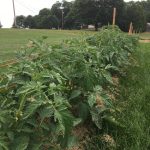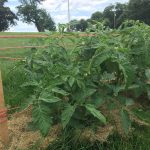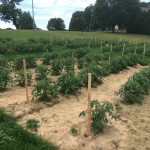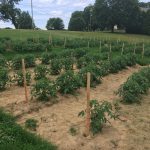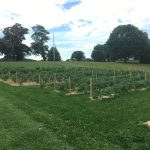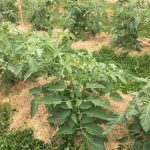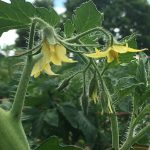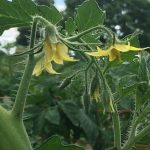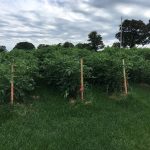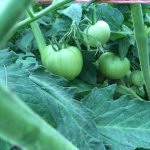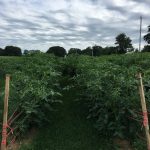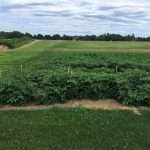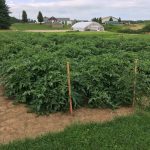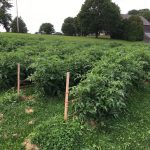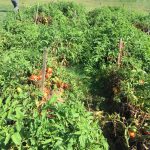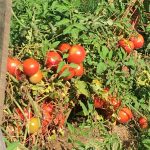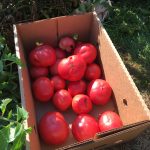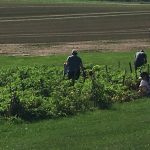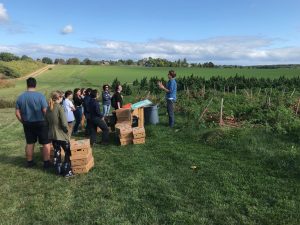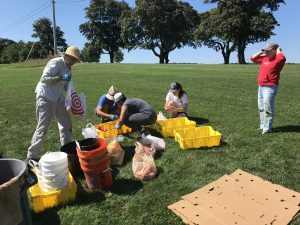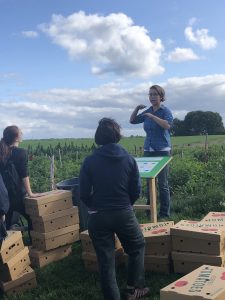Final report for FNE19-927
Project Information
This project sought to determine whether interplanting Microclover Black Beauty sod as a living mulch and as a cover crop would affect the fruit yield and nutrient status of organic tomato plants at 50% and 25% reduced fertilization rates. The experiment was conducted in a 64’x 60’ area of fully mature Microclover Black beauty turf, containing 3 treatments:
- 5-inch rows strip-tilled directly into established Microclover Black Beauty sod, green manuring the sod in rows and leaving 4 ft of the legume/grass mix as a living mulch on either side of the tilled bed.
- 5-inch rows of sod completely removed from the Microclover Black Beauty, leaving 4 ft of the legume/grass as a living mulch on either side of the tilled bed.
- Sod removed from the entire area, leaving the soil bare, without green manure or living mulch.
Each treatment was replicated 3 times and organized in a fully randomized 3×3 grid. The grid was configured so that the entire experiment consisted of 12 rows with 30 plants per row. Nine 20’ X 20’ plots were super-imposed over this planting. Each of the nine plots contained 4 rows of 10 plants each, split into two fertilizer treatments (50% and 25% of the recommended N rate). Plots were watered by drip irrigation and exposed soil was mulched with Microclover Black Beauty Turf Mix clippings. Plants were trellised when they exceeded 2 ft in height using 6ft wooden stakes and nylon string, and the trellising was updated as needed thereafter. Just prior to harvest, leaf tissue was sampled in each of the 18 plots and sent to UConn’s soil and plant testing lab to measure plant nutrient status. Vegetable plant productivity levels were measured by recording lbs of fruit harvested per treatment block.
There was not a noticeable difference in nutrient status or yield between experiment and control groups. While we cannot say that interplanting Microclover Black Beauty as living mulch and semi-permanent cover crop improves health or yield of tomato plants, we can say that the system produces an equitable crop at a reduced fertilizer rate, which represents an input and cost savings for the farmer. Furthermore, in addition to promoting better rainfall filtration, soil structure, and organic matter accumulation, the Microclover sod suppresses weeds between the rows, sparing the farmer the labor and cost to mulch or cultivate the weeds by other means. With proper trellising to give mowers access to the rows between plants, the system could be a neat, more sustainable, organic vegetable production system.
In 2018, we used an established Microclover Black Beauty turf as both a living mulch and a green manure to grow a variety of garden vegetables using strip tillage, leaving 90% of the turf undisturbed. We would like to explore this production system further to determine:
- If we can reduce external fertilizer input by at least 50% of the rate recommended by the 2012-2013 New England Vegetable Management Guide while maintaining a similar or superior level of marketable field tomato production to that of a traditional growing system.
- If substitution of green manure for most of the fertilizer affects plant nutrient status just prior to the beginning of tomato harvest.
- If living mulch growing on either side of the rows of tomatoes contributes any additional benefits to the crop.
Fitting soil-building cover crops into intensive vegetable farm rotations can be challenging, especially on small RI farms. Soil disturbance used in high-value vegetable production impacts soil health and reduces productivity and farm profitability.
To maximize productivity and profit, farmers need to reduce inputs without sacrificing soil health. To this end, cover cropping for the sustainable improvement of soil is widely researched and demonstrated, but an effective cover crop requires an extended growing period to build sufficient nutrient and biomass levels prior to green manuring, during which time the field is unproductive. Local farmers visiting year 1 of the Microclover Vegetable Growing System in 2018 expressed an interest in a growing method that fits soil-building cover crops into intensive vegetable farm rotations and addresses primary farming challenges:
1) Fertilization. Plant-soluble synthetic fertilizers offer almost immediate nutrient availability at comparatively low cost, but contributes nothing to soil organic matter content. Plants quickly use up the nutrients immediately surrounding their roots, and frequent re-application is required to maintain plant vigor. Available nutrients not taken up by plants may leach, causing nutrient pollution which may result in eutrophication. Organic fertilizer made up of organic matter supports microbial life and provides nutrients for an extended time. However, it is expensive, even cost-prohibitive to produce and spread.
2) Soil Health. Through photosynthesis, plants absorb atmospheric carbon. What carbon they don’t use, they exude through the roots, whereby soil organisms stabilize and store it. Over time, the soil becomes rich in carbon, well-aggregated, and better able to hold water. However, when a field is tilled, the aggregates are crumbled, soil biological activity is interrupted, and carbon is released back into the atmosphere. The bare soil is left vulnerable to erosion, leaching and runoff, and renewed cycles of weeds. Putting in a new groundcover quickly presents an input and labor cost.
3) Weed suppression. Left unchecked, weeds will rob a crop of nutrients, water, space, and sunlight. The three main ways of managing weeds incur significant disadvantages:
- a) Herbicides effectively kill weeds, but also may affect non-target life forms. Herbicides are an input cost to the inorganic farmer, and most are prohibited altogether to the organic farmer due to the health and environmental risks imposed by their toxicity.
- b) Mulching. Many opt to smother weeds with a black plastic However, although black plastic is an approved material by organic standards, it is a petroleum product. Its manufacture causes water and air pollution and its disposal will eventually see it in a landfill. Organic mulches like straw smother weeds, add organic matter to the soil, and help conserve soil moisture and tilth, but application over a large area is very labor intensive.
- c) Manual and mechanical. While this method is popular for its sustainability, the labor required makes it the single biggest production cost for organic farmers.
Farmers more conscious of soil health replenish organic matter and nutrients by planting cover crops and turning them back into the soil, a practice otherwise known as green manuring. Crops chosen are easy to grow and play important roles. Legumes such as peas, alfalfa, and clover are popular as cover crops for their nitrogen-fixing properties. A symbiotic interaction between legume roots and rhizobia form visible “polyploid cells housing thousands of bacteroids. Mature nodules actively fix nitrogen until they enter senescence upon aging or stress.” (Dupont et.al.) As they senesce, they release the bacteria and stored nitrogen into the soil for current and future crop use. “Legumes such as clover or hairy vetch can fix between 100 and 200 pounds of nitrogen in a single growing period.” (Brust).
While grasses like sorghum or rye do fix nitrogen, they are primarily grown to increase soil organic matter content, which is mainly composed of carbon. Grasses do “scavenge” nitrogen from previous crops and the soil, preventing it from being lost by leaching. “A mixture of both grasses and legumes can be used to obtain the advantages of each.” High levels of organic matter in a soil will improve soil tilth and root growth, optimizing a crop’s ability to take up nutrients (Brust).
A few SARE-funded grant projects have experimented with perennial mulches and green manuring to improve soil health and crop production. In 2016, Nadine Burton successfully used cowpea as a green manure to boost pak choi yield and nutrient content on the Delmarva. Burton fully incorporated the herbaceous legume and mulched her experiment plots with black plastic mulch. Dr. Sid Bosworth is conducting an ongoing experiment in Vermont that evaluates the effects of perennial living mulches on corn silage production in the Northeast. Bosworth’s project uses a leguminous mix of clover and vetch to scavenge nutrients and prevent soil erosion during the 7 months of the year that corn is not planted. His system kills the perennial living mulch in narrow rows and no-till plants the corn in those rows. Corn and pak choi require different growing specifications than tomatoes however. With a set-up similar to Sodco’s Microclover Vegetable Growing System, Albert Brandon’s 2016 SARE experiment interplanted tomatoes in a well-established white clover living mulch to test its effect the on plants’ resistance to fungal and bacterial disease.
Sodco is a Rhode Island turf farm that has focused on the improvement of soil health through cover cropping since 2010. In 2014, Sodco introduced the leguminous Microclover – smaller, determinately flowering cousin of white clover -- to their turf fields and changed the way sod could be grown. When added to Black Beauty, Jonathan Greene’s drought-tolerant fine fescue mix, it results in a sod that can be maintained without chemical fertilizers and with 30-50% less water in good conditions than a traditional bluegrass would require, making it both financially and environmentally sustainable.
Having seen success significantly reducing fertilizer inputs on sod, in 2018 Sodco brought Microclover’s nitrogen-fixing power to vegetable farming. In year 1 of the Microclover Vegetable Growing System, they tilled 5-inch rows directly into an area of fully mature Microclover Black Beauty sod, leaving at least 4 ft of grass undisturbed between the rows. One week prior to planting, they fertilized the tilled areas at 50% of the recommended rate with an organic 5-4-5 starter fertilizer and incorporated it into the soil along with the Microclover Black Beauty green manure. Tomato, bell pepper, and squash was planted in the tilled soil and irrigation tape was laid along the rows. Clippings mowed from the Microclover Black Beauty fields were vacuumed and used to mulch the exposed soil. No additional fertilizers were applied.
The first-year experiment results were very promising. The plants were healthy and highly productive throughout the entire growing season and the grass clipping mulch and living cover crop between the rows effectively blocked weeds. We would like to look at the potential of this experiment as an on-going production system. To that end, the vegetable plants were pulled after harvest and the rows were re-seeded with Microclover Black Beauty sod, renewing the area for year 2 of the experiment, where vegetable rows will be tilled 1 ft to the side of where they were planted the previous year. By reducing tillage and external fertilization while always keeping the ground covered with an effective green manure, this system has the potential to sustainably produce high-yield vegetable crops indefinitely with minimal external inputs and without exhausting the soil where land is scarce.
Citation List
Bosworth, Sid. (2017). “Evaluating the the perennial living mulches in a silage corn production system in the Northeast.” SARE Project
ONE17-299. Burlington, VT; University of Vermont.
Brandon, Albert. (2017). “Effect of perennial living mulch on mycorrhizal infection, disease severity, and marketable yield of organic tomatoes.” SARE Project FNE16-838. West Kingstown, RI; University of Brandon Family Farm.
Brust, Gerald. “Chapter 5: Soil Fertility and Cover Cropping.” Organic Vegetable Production Manual. Upper Attleboro, MA. https://extension.umd.edu/sites/extension.umd.edu/files/_docs/programs/mdvegetables/Chap5-Soil-Fertility-Cover-Crops-web-version.pdf
Burton, Nadine. (2016). “Evaluating the effects of green manure and biofertilizers on pak choi yield, minerals, and phytonutrient contents.” SARE Project GNE15-096. Princess Anne, MD; University of Maryland Eastern Shore.
Laurence Dupont, Geneviève Alloing, Olivier Pierre, Sarra El Msehli, Julie Hopkins, Didier Hérouart and Pierre Frendo (2012). “The Legume Root Nodule: From Symbiotic Nitrogen Fixation to Senescence”, Senescence, Dr. Tetsuji Nagata (Ed.), ISBN: 978-953-51-0144-4, InTech, Available from: http://www.intechopen.com/books/senescence/the-legume-root-nodule-from-symbiotic-nitrogen-fixation-tosenescence
Hazzard Ruth, Howell John (2013). 2012-2013 New England Vegetable Management Guide. Amherst, MA. University of Massachusetts, Extension Vegetable Program.
References
1 Microclover® (Trifolium repens var. pirouette) was initially developed in Denmark by DLF Trifolium and introduced in the US around 2005.
Sodco, Inc. is a 526 acre sod farm with average annual gross sales of 4.5 million selling 9 varieties of sod, including industry revolutionizing sustainable commercial sods, Black beauty and Microclover Black Beauty, as well as corn for biofuel. John Eidson, Farm Manager at Sodco since 2010, is a lifelong Rhode Island farmer with extensive experience in cover crops, forages, and turfgrass. Invented and managed year 1 of the experimental Microclover Vegetable Growing System (2018).
Cooperators
- - Technical Advisor
- (Researcher)
Research
Prior to set up, a comprehensive soil test was conducted on the experiment plot (See Table 1), a Bridgehampton Silt Loam. The experiment was conducted in a 64’x 60’ area of fully mature Microclover Black beauty turf, containing 3 treatments:
- 5-inch rows strip-tilled directly into established Microclover Black Beauty sod, green manuring the sod in rows and leaving 4 ft of the legume/grass mix as a living mulch on either side of the tilled bed.
- 5-inch rows of sod completely removed from the Microclover Black Beauty, leaving 4 ft of the legume/grass as a living mulch on either side of the tilled bed.
- Sod removed from the entire area, leaving the soil bare, without green manure or living mulch.
Each treatment was replicated 3 times and organized in a fully randomized 3×3 grid. The grid was configured so that the entire experiment consisted of 12 rows with 30 plants per row. Nine 20’ X 20’ plots were super-imposed over this planting. Each of the nine plots contained 4 rows of 10 plants each, split into two fertilizer treatments:
- Organic Fertilizer (5-4-4) applied at 50% of the N rate recommended by the New England Vegetable Management Guide (150# N/acre total), once at time of planting.
- Organic Fertilizer applied (5-4-4) at 25% of the N rate recommended by the New England Vegetable Management Guide (150# N/acre total), once at time of planting.
Drip irrigation tape attached to a manual water valve was laid along each row and all exposed soil was mulched with Microclover Black Beauty Turf Mix clippings. Plants were trellised when they exceeded 2 ft in height using 6ft wooden stakes and nylon string, and the trellising was updated as needed thereafter. By mid-July, the vines of the tomato plants had grown so tall and heavy that they collapsed the trellising. Three attempts were made to reinforce the trellising using supplemental wooden stakes, but the growing fruit weighed the vines down further and the wooden stakes and nylon string proved insufficient to keep the vines off the ground. If the experiment were repeated, a sturdier trellising system should be used.
In late July, just prior to harvest, leaf tissue was sampled in each of the 18 plots and sent to UConn’s soil and plant testing lab to measure plant nutrient status. Vegetable plant productivity levels were measured by recording lbs of fruit harvested per treatment block. Tomatoes were gathered and sorted into boxes labeled by quadrant and the boxes were weighed on a standard scale. The tomatoes were harvested by groups of volunteer harvesters on 20 harvesting days between August 29th, 2019 and September 30th, 2019. On one of these days, September 3rd, the data recording which boxes came from which quadrants was lost.
One week prior to what would have been the last scheduled harvest, a killing frost hit the farm and all the plants were withered overnight.
This was a two-factor experiment: fertilizer level and soil treatment. With two fertilizer levels and three soil treatments, there was a total of six treatments. All data was analyzed using Two-way ANOVA with replications on Microsoft Excel.
|
Table 1: Yields of ungraded and graded fruit soil treatment and partially amended plots (lbs. per 40-plant plot) |
|||
|
Ungraded fruit |
|||
|
Treatment means ± Std Dev |
|||
|
Fert Rate |
Green manure |
Strip removed |
Bare soil |
|
25% |
170 ± 84 |
201 ± 30 |
156 ± 18 |
|
50% |
157 ± 16 |
147 ± 61 |
157 ± 69 |
|
Graded fruit |
|||
|
Treatment means +/- Std Dev |
|||
|
Fert Rate |
Green manure |
Strip removed |
Bare soil |
|
25% |
64 ± 35 |
107 ± 37 |
83 ± 20 |
|
50% |
92 ± 24 |
85 ± 60 |
96 ± 65 |
Statistical analysis revealed that no significant differences were detected neither between ungraded yields among any of the treatments nor graded yields, although in the latter case, because of a handling mishap, good data was not recorded because of a misunderstanding. Also, plants grew very vigorously and were not pruned enough, which made harvesting difficult: fruit in the interior may have rotted or been missed. As noted above, several staking/trellising structures collapsed.
|
Table 2: Tomato leaf tissue macronutrient concentrations for all treatments |
||||
|
Element concentrations (%) |
||||
|
Element |
Fert level1 |
Green Manure2 |
Turf Strip Removed3 |
Bare Plot4** |
|
N |
0.25 |
3.94 |
3.77 |
4.05 |
|
0.5 |
4.03 |
3.85 |
4.31 |
|
|
P |
0.25 |
0.26 |
0.26 |
0.27 |
|
0.5 |
0.28 |
0.28 |
0.29 |
|
|
K** |
0.25 |
3.18 |
3.09 |
**4.46 |
|
0.5 |
3.55 |
3.18 |
3.75 |
|
|
Ca |
0.25 |
1.44 |
1.76 |
1.51 |
|
0.5 |
1.53 |
1.65 |
1.52 |
|
|
Mg |
0.25 |
0.45 |
0.50 |
0.57 |
|
0.5 |
0.50 |
0.51 |
0.54 |
|
|
1 0.25 indicates one fourth recommended rate of N, 0.5 indicates one half recommended rate of N 2 Existing microclover/grass turf incorporated into soil 3 Existing microclover/grass turf strip removed but alleys left intact 4 Existing microclover/grass removed from entire plots **Indicates highly significant treatment effect |
||||
Table 2 shows leaf tissue nutrient concentrations of macronutrients (excluding Sulfur) at about the time of earliest fruit ripening. About 40 youngest fully expanded leaves were collected from each of the nine plots. The only nutrient which differed significantly among any of the treatments was potassium (K). Across both fertilizer treatments, K leaf tissue concentration was highest in the bare plot treatment. Also, there was a significant Fertilizer X Plot Treatment effect, with the Low Fertilizer X Bare Plot combination resulting in the highest leaf tissue K.
Discussion
Of the fruit yield results, the ungraded yield is more useful since there was an error in handling that would have determined marketable yield. That there were no differences among treatments may indicate that reducing N fertilizer recommendation to 25% of what is typical has no effect on productivity of the tomato plants. This can be considered a positive outcome.
The highly significant differences in K are difficult to explain without further investigation, given that organic matter was not incorporated in the bare plot and that K leaf tissue concentration was higher in plots amended with less N.
|
Table 3: Soil Test Results, March 28, 2019. Values for nutrients are in ppm. |
|
|
Soil pH |
6.7 |
|
Electrical Conductivity |
0.14 |
|
P (ppm) |
132.8** |
|
K (ppm) |
172.0* |
|
Ca (ppm) |
651.0 |
|
Mg (ppm) |
133.0 |
|
CEC |
4.8 |
|
**Very high |
|
|
*High |
|
Table 3 shows soil test data collected prior to the study. This farm has historically high soil test P, though none has been applied for several years on any fields. The existing high soil test K may have obscured treatment differences. Another factor for consideration is competition from living mulch in the two treatments in which it was left intact.
The microclover/turf mix had been strongly established for nearly two years prior to the study. If such a green manure crop is being used on a small, diverse vegetable farm, it is likely that this period would be shorter since ground is precious in a smaller operation. It would be useful to recreate this trial using a younger turf planting.
Maintaining established turf between high value vegetable beds can be an effective way to maintain solid soil cover. This promotes better rainfall infiltration, promotes soil structure and organic matter accumulation, and fixes some nitrogen. Keeping it mowed and relatively weed free is critical- the idea is to grow beneficial ground cover species, not mowed weeds.
This project sought to determine whether interplanting Microclover Black Beauty sod as a living mulch and as a cover crop would affect the fruit yield and nutrient status of organic tomato plants at 50% and 25% reduced fertilization rates. There was not a noticeable difference in nutrient status or yield between experiment and control groups. While we cannot say that interplanting Microclover Black Beauty as living mulch and semi-permanent cover crop improves health or yield of tomato plants, we can say that the system produces an equitable crop at a reduced fertilizer rate, which represents an input and cost savings for the farmer. Furthermore, in addition to promoting better rainfall filtration, soil structure, and organic matter accumulation, the Microclover sod suppresses weeds between the rows, sparing the farmer the labor and cost to mulch or cultivate the weeds by other means. With proper trellising to give mowers access to the rows between plants, the system could be a neat, more sustainable, organic vegetable production system.
Education & Outreach Activities and Participation Summary
Participation Summary:
The farm hosted many tours of its sustainable agriculture projects, including the SARE experimental plot. In May, an informational placard, attached, was posted in front of the plot to serve as an educational tool for the public. In addition to this, lectures about the experiment were given to the volunteer harvesters, including a group of high school student volunteers from North Kingston High School.
Learning Outcomes
Cover cropping, sustainable fertilization, and soil health promotion.
Project Outcomes
Sodco is a sod farm that will not likely continue to use an organic vegetable production system on a significant scale. We will, however, continue to use cover crops to prevent soil erosion, suppress weeds, accumulate organic matter and promote soil quality.
The largest challenge presented by this experiment was keeping up with the plants' vigorous growth and providing adequate trellising. This system will be most beneficial to farmers who either trellis with very sturdy trellising or adequate pruning to reduce the weight of the plants, or both. Keeping the vines pruned and off the grass will allow ground mowers to be run between the rows throughout the entire experiment, will prevent living mulch rows from being smothered by the vines, and will give harvesters better access to fruit on the inside and lower portions of the plants. The information garnered from this experiment will most benefit organic and sustainable vegetable farmers, as the system could keep their land in simultaneous cover crop and cash crop production.
